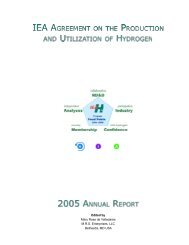Technology Status of Hydrogen Road Vehicles
Technology Status of Hydrogen Road Vehicles
Technology Status of Hydrogen Road Vehicles
Create successful ePaper yourself
Turn your PDF publications into a flip-book with our unique Google optimized e-Paper software.
part <strong>of</strong> the inlet stroke. It is thus characterized as being at essentially ambient pressure, and at a temperature<br />
from near-ambient down depending on hydrogen storage temperature.<br />
At its simplest, the hydrogen can come from a single device that meters the quantity for each cylinder in turn.<br />
This would be analogous to the single carburetor <strong>of</strong> simple gasoline engines, but has the great disadvantage<br />
for hydrogen <strong>of</strong> making the whole inlet manifold subject to backfire. Somewhat more complicated is the timed<br />
injection where each inlet port is supplied with low-pressure hydrogen, limiting the backfire-prone mixture<br />
to that in the immediate vicinity <strong>of</strong> each cylinder. This line also preserves the advantages <strong>of</strong> multi-port<br />
sequential fuel injection as in modern gasoline ICEs: less mixture variation, improved acceleration, better<br />
volumetric efficiency, and elimination <strong>of</strong> the carburetor or similar device, which insert pressure barriers to the<br />
mixture.<br />
With low-pressure hydrogen injection typical <strong>of</strong> external mixture formation, the injectors are relatively simple,<br />
and can have a metering function only if the hydrogen storage pressure is high enough (which is usually the<br />
case). The air flow is unthrottled, but the incoming hydrogen occupies considerable space because <strong>of</strong> its low<br />
density. Turbocharging the air can help, but the relative power loss <strong>of</strong> hydrogen compared to gasoline remains<br />
as high as 40%. Simple mass considerations show this loss to be at least 15%.<br />
As with gasoline the inlet valve can be closed about halfway through the compression stroke, compression can<br />
proceed to about 10:1 ratio, and spark ignition can occur in the final part <strong>of</strong> the stroke depending on engine<br />
speed. The expansion and exhaust strokes proceed generally as in a gasoline engine, but hydrogen and its<br />
combustion products with air (essentially only H 2O and small amounts <strong>of</strong> NO x) can also lodge in cylinder<br />
recesses and be present during the inlet stroke.<br />
At low engine speed and load, hydrogen combustion with external mixture formation proceeds smoothly over<br />
a wide range <strong>of</strong> lean mixtures. Thermal efficiencies are high, and the exhaust contains only trace quantities<br />
<strong>of</strong> NO x (the low temperatures <strong>of</strong> lean mixtures block NO x formation), as well as inevitable traces <strong>of</strong> CO and<br />
CO 2 typical <strong>of</strong> lubricating oil combustion. Unfortunately, this excellent result starts deteriorating toward midpowers<br />
and speeds with the advent <strong>of</strong> rough combustion caused by pre-ignition and backfire. The NO x levels<br />
can increase rapidly and power levels typical <strong>of</strong> gasoline engines cannot be achieved, not only because <strong>of</strong><br />
hydrogen’s low density, but also because <strong>of</strong> deteriorating combustion.<br />
The phenomena at work in irregular combustion during the inlet stroke have no doubt been investigated by<br />
most researchers, but the most complete reporting has been made by Musashi Institute <strong>of</strong> <strong>Technology</strong>.<br />
Koyanagi et al. (1994) describe the definitive experiments on a single-cylinder engine supplied with hydrogen<br />
from a relatively large reservoir with spark plug ignition at 231 BTDC and 10:1 or 12:1 compression ratio.<br />
Temperatures were measured by thermocouples near the surface <strong>of</strong> the spark plug, object lenses followed the<br />
luminescence <strong>of</strong> the flame, recorded either by photomultiplier or by high-speed video camera, and <strong>of</strong> course<br />
crank angle and internal pressures were recorded. They found that:<br />
! Backfiring occurred more easily and frequently with leaner mixtures and at the lower compression ratio,<br />
i.e., at lower temperatures.<br />
! The spark plug can be eliminated from consideration as the source <strong>of</strong> pre-ignition and backfire.<br />
! Special pistons with enlarged radial clearance at top land clearly showed that the exhaust gases trapped<br />
in this clearance volume were the source <strong>of</strong> pre-ignition and backfire.<br />
Because little can be done to eliminate such residual pockets <strong>of</strong> hot exhaust gas, the Musashi researchers seem<br />
to have abandoned external mixture formation, because most <strong>of</strong> their remaining reports deal only with internal<br />
mixture formation. Others prefer to continue with the external mixture formation, and ascribe the backfire<br />
to other causes such as spark plugs and hot exhaust valves, but they try to get around the problem by two lines<br />
33













